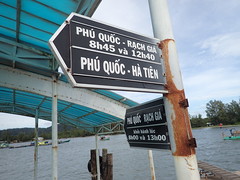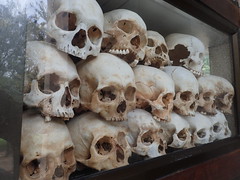This post touches on the dark side of humanity; past, present and most likely future. So buckle up.
Yesterday we departed our island paradise to travel by sea and land to our next destination, Phnom Penh, Cambodia. The itinerary suggests eleven hours of travel, hopping from van to boat to bus to van to cover roughly the same distance as the 35 minute flight here from Saigon a few days prior. Standing at the docks on the east side of Phu Quoc, our ferry appears in the distance then docks at the pier. Passengers disembark with a few pausing on the concrete steps to rid themselves of their breakfast. Not a good sign for anyone prone to motion sickness. Seas are fairly high with 6 to 8 foot waves. Scooters parked on the bow are offloaded and we then board the ship for our journey to Ha Tien, Vietnam, a mere 4 miles from the Cambodian boarder. The ship’s powerful engines speedily smash through the high surf, sea spray cast against the view ports giving the illusion of a raging storm. A projection screen soon glows with a campy 1992 Vietnamese comedy subtitled in English. The Vietnamese must enjoy all things phallic considering every joke involved a penis and the ship’s parent company is named SuperDong.
Once in Ha Tien, a crude, rude worm of a handler greets us for the paperwork chore of passports and visas to leave Vietnam and enter Cambodia. Sacrificing our passports and money ($10 of which goes to the handler as his fee), we wait two hours for a bus to carry us four miles to the boarder. We joke how we could have walked the distance in half the time. The bus finally arrives and we are reunited with our handler, now all smiles, showing that our passports are all in order with a new Cambodian visa in each. We continue west to the seaside resort town of Kep where we change vehicles to board a 12 passenger van northbound to Phnom Penh. Over rough roads, with shocks and springs completely shot, the ride was borderline terrifying, feeling as if we were riding out a class 5 hurricane in a sheet metal shit shack. Vehicles would pass three abreast then barely squeeze back into their lane just before an oncoming vehicle promised horrific destruction, all the while scooters clinging to each narrow shoulder. More fortunate passengers managed to doze during this fright show while I simply laughed out loud at each near collision.
During a restroom break, an ex-pat pointed out flat-bed trucks rolling past. Standing atop were 50 women, 10 deep and 5 abreast, pressed next to one another and clinging to a flimsy metal cage arching over their heads. These, he explained, are the garment workers, being carried to their jobs not unlike cattle to slaughter. Dull eyes on deadpan faces tell the story of their daily ritual of endless toil. Occasionally trucks are involved in a roll over or collision, their frail bodies smashed and strewn on the pavement. All for a wage of $155 per month.
Continuing on, bone white Quasimoto cattle graze thin grass leaving soggy low spots to mocha water buffaloes. Demolition derby conditions eased to a slow crawl as we entered the gridlock within Phnom Penh. Easily the least desirable city I’ve seen while in Indochina, it is best described as a smoldering landfill. Choking vehicles emit a heavy smog while indifferent residents wade alongside mountains of roadside trash. Arriving at the bus depot at 7:00 pm, we slog one mile south through dirty markets and putrid oder. Not a very good first impression this country called Cambodia.
Today is a lesson of the atrocities a government can commit against its own unarmed defenseless people; we’re visiting Choeung Ek, better known as The Killing Fields, ten miles south. During a four year stretch in the 1970s, a ruthless sociopath came to power in Cambodia. Known as Pol Pot, he tortured and slaughtered 3 million Cambodians, nearly 40% of the population. Gaining strength from poor, uneducated country folk, he built his Khmer Rouge around an army of child soldiers. The educated, bi-lingual, doctors, lawyers, teachers and even anyone wearing glasses was gathered and murdered. Small children were held by their ankles then smashed against trees. Mothers, forced to bear witness were bludgeoned with hoes, clubs, machetes, or hammers (because bullets were too expensive) then tossed in a mass grave atop their lifeless toddlers.
The Killing Fields is a grim reminder of the dark nature of Man. Surrounded on two sides by shoddy neighborhood, this field of land is one of many mass graves scattered throughout the country. Walking a self-guided path, headsets explain the horrors committed here less than 40 years ago with 18 numbered stops, the last being a nine story stupa with the skulls of 9,000 souls. Hardly a joyful vacation destination, it’s a must see stop for anyone who thinks, “Could never happen in my backyard.” I’m sure the Cambodians had the same thought.











